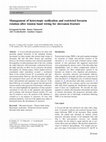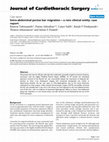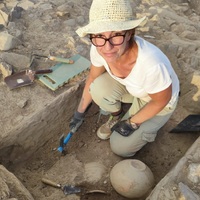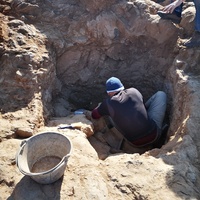Papers by Ramon Tahmassebi
Journal of Shoulder and Elbow Surgery
Before the 1900s, distal radius fractures were misdiagnosed as radiocarpal dislocations and most ... more Before the 1900s, distal radius fractures were misdiagnosed as radiocarpal dislocations and most were treated nonoperatively. Between the 1900s and 1920s there were several anesthesia and antiseptic advancements that led to the advancement of surgical interventions. Then after the continued use and implementation of radiographs in orthopedics, radiographic parameters allowed for a critical analysis of treatment and patient outcomes that led to the further advancement of distal radius fracture treatment. This review will detail the historical content that led us to current practices. Additionally, current methods are critiqued, and common complications are reviewed in order to allow orthopedic surgeons to avoid these complications today.
BackgroundManagement of complex lateral end clavicle fractures with coraco-clavicular ligament di... more BackgroundManagement of complex lateral end clavicle fractures with coraco-clavicular ligament disruption can be challenging.MethodsWe prospectively analysed 19 (17 M:2F) patients from January 2014...

Bone & Joint Open
Aims As the world continues to fight successive waves of COVID-19 variants, we have seen worldwid... more Aims As the world continues to fight successive waves of COVID-19 variants, we have seen worldwide infections surpass 100 million. London, UK, has been severely affected throughout the pandemic, and the resulting impact on the NHS has been profound. The aim of this study is to evaluate the impact of COVID-19 on theatre productivity across London’s four major trauma centres (MTCs), and to assess how the changes to normal protocols and working patterns impacted trauma theatre efficiency. Methods This was a collaborative study across London’s MTCs. A two-month period was selected from 5 March to 5 May 2020. The same two-month period in 2019 was used to provide baseline data for comparison. Demographic information was collected, as well as surgical speciality, procedure, time to surgery, type of anaesthesia, and various time points throughout the patient journey to theatre. Results In total, 1,243 theatre visits were analyzed as part of the study. Of these, 834 patients presented in 201...
Journal of Hand Surgery (European Volume)
The surgical referral policies for patients with trigger finger, ganglion removal and Dupuytren’s... more The surgical referral policies for patients with trigger finger, ganglion removal and Dupuytren’s disease were collected for all Clinical Commissioning Groups in England. The aim was to assess whether there was variation in the policies across England, resulting in inequality in patients’ access to surgery. Data were collected between October 2018 and January 2019 and compared with national guidelines. Analysis of the results showed that for all three conditions, surgical commissioning policies varied depending on the locality. The results also show that despite the existence of national guidelines, they are not implemented. This has the potential to lead to variation in surgical referral and access to services for patients in different localities in England. Level of evidence: III
European Journal of Orthopaedic Surgery & Traumatology
Emergence of the Covid-19 pandemic resulted in dramatic changes in global healthcare provision. R... more Emergence of the Covid-19 pandemic resulted in dramatic changes in global healthcare provision. Resources were redirected across all healthcare sectors to support the treatment of viral pneumonia with resultant effects on other essential services. We describe the impact of this on the provision of major trauma care in a major capital city.
The Journal of hand surgery, 2014
The Journal of Hand Surgery, 2015
Hand Surgery, 2015
The surgical aims in managing displaced intra-articular fractures of the base of the middle phala... more The surgical aims in managing displaced intra-articular fractures of the base of the middle phalanx include early joint reduction, maintaining congruence and early mobilization. Achieving this can be a challenge. However dynamic external fixators offer a solution. The study aim was to evaluate the use and outcomes of the Ligamentotaxor external fixator in patients with such injuries.

The Journal of hand surgery, European volume, Jan 2, 2015
Symptomatic malunited metacarpal fractures can significantly affect hand function. We retrospecti... more Symptomatic malunited metacarpal fractures can significantly affect hand function. We retrospectively reviewed the results of our technique of corrective osteotomy in 14 malunited metacarpal fractures (12 patients) with an average age of 30 years (range 18-49) from January 2005 to December 2011. The dominant hand was involved in nine patients and all except one were male. The malunited metacarpals demonstrated mean dorsal apex angulation of 43° (range 33°-72°) with apparent metacarpal shortening. All except three cases had rotational deformity. All patients underwent surgical correction of the deformity using our described technique of closing wedge osteotomy using temporary intramedullary K-wire and plate fixation. At a mean follow-up of 46 months (range 12-78), the DASH scores improved significantly (p < 0.001). All our patients scored 'excellent' according to the Büchler criteria and at final follow-up had returned to pre-injury work and sports activities. Our techniqu...

Strategies in Trauma and Limb Reconstruction, 2014
A 32-year-old lady presented to our clinic with persistent painful restriction of her dominant fo... more A 32-year-old lady presented to our clinic with persistent painful restriction of her dominant forearm movements for three months after tension band wiring of olecranon. She had full elbow flexion and extension; however, her forearm rotations were restricted and painful. Investigations revealed prominent tips of the wire, eroding the radial tuberosity with heterotopic ossification between the radius and ulna. As there was no synostosis, the patient had implant exit. During surgery, before implant removal, examination under anaesthesia revealed a mechanical block of the rotation beyond 30°on pronation and supination from neutral. However, after the removal of implant, the mechanical block eased off and with gentle manipulation, full pronation and supination were achieved. At the final follow-up at 6 months, the patient had full pain-free forearm rotation with regression of heterotopic ossification. Our case report highlights the importance of intra-operative assessment of wire tips at full supination and pronation, and in patients with restricted forearm rotation, CT scan may be needed to assess the position of the hardware is essential as it can progress to synostosis. In cases with prominent hardware, removal of the implant may suffice if performed before the development of synostosis

Journal of Cardiothoracic Surgery, 2008
We present the case of a 20-year-old male who underwent successful surgical correction of pectus ... more We present the case of a 20-year-old male who underwent successful surgical correction of pectus excavatum with the Highly Modified Ravitch Repair (HMRR). At 29 months the attempted operative removal of the Ravitch bar was unsuccessful despite the impression of adequate bar location on chest x-ray. Subsequent imaging with computed tomography was unclear in determining whether the bar was supra or infra-diaphragmatic due to the tissue distortion subsequent to initial surgery. Video assisted thoracoscopic surgery (VATS) successfully retrieved the bar and revealed that it was not in the thorax, but had migrated to the intra-abdominal bare area of the liver, with no evidence of associated diaphragmatic defect or hernia. Intra-abdominal pectus bar migration is a rare clinical entity, and safe removal can be facilitated by the use of the VATS technique.

Journal of Hand and Microsurgery, 2014
The 4-strand cross-locked cruciate flexor tendon repair technique (Adelaide technique) has been s... more The 4-strand cross-locked cruciate flexor tendon repair technique (Adelaide technique) has been shown to have comparably high resistance to gap formation and ultimate tensile strength. This study aimed to determine whether an interlocking modification to the Adelaide repair would impart improved biomechanical characteristics. Twenty four sheep flexor tendons were harvested, transected and repaired using either standard or modified Adelaide techniques. Repaired tendons were cyclically loaded. Gap formation and ultimate tensile strength were measured. Additionally, suture exposure on the tendon surface was determined. There was a statistically significant increase in resistance to gap formation in the early phase of cyclic loading within the modified Adelaide group. In the later stages of testing no significant difference could be noted. The average final load to failure in the modified group was higher than the standard group but this did not achieve statistical significance. Interlocking suture techniques in four strand tendon repair constructs can improve gapping behavior in the early phase of cyclic loading.










Uploads
Papers by Ramon Tahmassebi